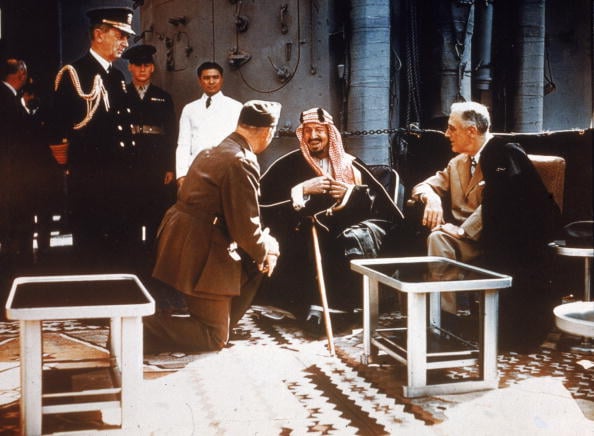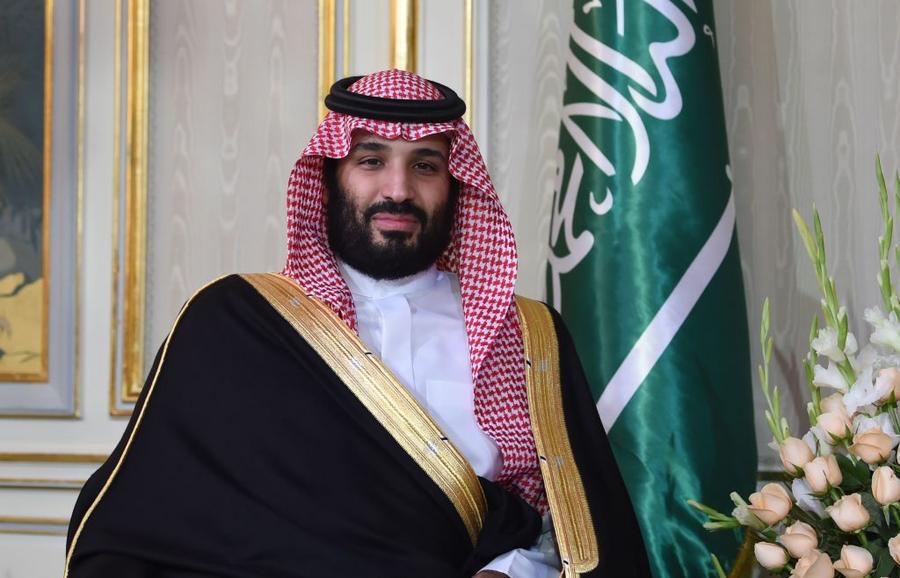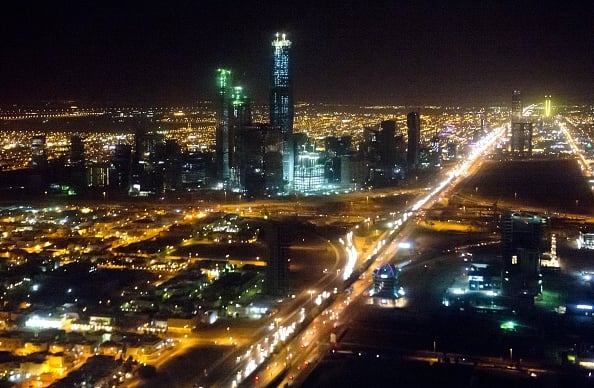A new Lamborghini and Range Rover in every driveway, pet tigers wearing diamond necklaces, $500 million private jets, oil gushing out of the ground with a slight pin prick, wiping your bottom with $100 bills. Gold-plated…everything.
It sounds absurd, but for a small circle of Saudis, that kind of life isn’t fantasy—it’s Tuesday. In fact, my description might not even be gaudy enough. Because the vast majority of these ultra-wealthy Saudi citizens are members of ONE family.
One family that controls literally trillions of dollars worth of oil and cold hard cash. A single family that can send world economies soaring or tumbling with the push of a button. This is the story of the origins of the House of Saud. AKA the Saudi Royal Family. AKA the luckiest group of people on the planet.
First off, this is what Saudi Arabia’s capital city of Riyadh looks like today:
SAUL LOEB/AFP/Getty Images
And the photo below is what Riyadh looked like at any point in history prior to roughly 100 years ago:

Fox Photos/Getty Images
Early History Of The House of Saud
The first Saudi dynasty was founded in 1744 by Muhammad bin Saud at a time when most of the region was loosely controlled by the Ottoman Empire (modern-day Turkey). Muhammad bin Saud gained a groundswell of popularity and power after aligning with an influential religious leader named Muhammad ibn Abd al-Wahhab. Together, the two men established a political movement called Wahhabism that was based on a puritanical form of Sunni Islam. They established their base in the city of Riyadh, but the “Saudi” state expanded rapidly to control most of the territory that today encompasses Saudi Arabia. The first Saudi state lasted until 1818, when it was destroyed by Egyptian-based Ottomans. Over the next 50 years, the Al Saud clan fought bitterly with a rival family, but they were eventually defeated and driven to exile in what is now Kuwait.
Ibn Saud Establishes A Kingdom
At the beginning of the 19th century, “Arabia” was little more than a loose patchwork of territories controlled by various tribal leaders. In 1902, Muhammad bin Saud’s great-great-great-great-grandson Abdul Aziz, who would later be known as Ibn Saud, led a group of family members in recapturing control of Riyadh. Ibn Saud’s influence spread quickly with the help of tribal leaders who were sympathetic to his goal of driving out the Ottomans and unifying Arabia under Wahhabism.
Ibn Saud and his upstart forces were not the only foes attacking the Ottoman Empire at the time. In 1916, the Ottomans were also in the midst of fighting the British during World War I. Seeing it as a way to weaken the Ottomans, the British gave Ibn Saud support and encouragement to form a unified Arab state. Over the next 10 years, Ibn Saud fought off a series of internal and external forces that opposed his plans. In 1926, Ibn declared himself King of the Hejaz, an area in Western Arabia. A year later, he declared himself King of Nejd, Arabia’s central region.
Finally, in 1930, Ibn Saud’s forces defeated their largest rival after a brutal two-year battle. With the victory, Ibn united the Hejaz and Nejd regions as the Kingdom of Saudi Arabia. He also executed every male member of his rival clan. On September 23, 1932, Ibn Saud officially crowned himself King of Saudi Arabia.
The Poorest Country in the World
Ibn Saud finally had a Kingdom his great-great-great-great-grandfather envisioned 150 years ago, but there was one big problem: After decades waging war to unify a mostly uninhabitable swath of desert that could barely sustain a cactus, the royal family was broke. Actually, the entire Kingdom was basically destitute. Most Saudis, including the royal family, subsisted on extremely limited agriculture and some minor tourism revenues from people making Islamic pilgrimages to Saudi landmarks like Mecca. It also didn’t help that the entire world was reeling from the Great Depression. All of a sudden, Muslim people from other countries couldn’t afford to make the pilgrimage to Saudi Arabia’s holy sites.
Discovery of Oil
Ibn Saud and his family were desperate. They needed a lifeline, and they hoped that lifeline might be oil. World War I had proven beyond a doubt that oil was going to be the most important natural resource on earth for the foreseeable future. At the time, thanks to discoveries in Texas and the Midwest, the United States was the world’s leading producer of black gold. In fact, significant quantities of oil had not been discovered anywhere in the Middle East at that time. Modest outputs were discovered in Persia (modern-day Iran) and Bahrain, but the geological community’s general consensus was that there was no oil in Saudi Arabia. This opinion further discouraged foreign banks from making loans to companies that might have been otherwise interested in conducting oil exploration within the Kingdom.
On the other hand, there were persistent rumors and local legends that oil had been seen seeping out of the ground in some extremely remote Saudi villages. So the Kingdom pressed ahead. Starting in 1935, a joint partnership between Standard Oil and the Texas Oil company called CALTEX began drilling near a desolate eastern Saudi village called Dammam. After three years of constant problems and setbacks, CALTEX made a discovery that would change the Kingdom of Saudi Arabia, the Middle East, and the world forever.
Oil was discovered in Dammam on March 3, 1938. It was incredible luck, but the royals still had no idea how much more oil they might find. For all they knew, Dammam would be their only discovery.
In 1949, American oil explorer Jean Paul Getty made an investment that most people thought was certifiably insane. Getty took $9.5 million of his own money (roughly $100 million today) and purchased a 60-year exclusive lease to search for oil in the eastern region of Saudi Arabia. Getty then spent an additional $30 million of his own money ($300 million today) searching his claim for black gold. In 1953, the gamble paid off ENORMOUSLY. From that point forward, his little tract of worthless land would go on to produce 16 million barrels of oil every year. Thanks to his Saudi fields, Getty would soon become one of the first human beings to possess a billion-dollar fortune, without adjusting for inflation.
Then came the Ghawar oil field, which began full-time production in 1951. That field turned out to be the largest single deposit of crude oil on the planet. During its lifetime, Ghawar is expected to produce 75-83 billion barrels of oil. Today, six of the world’s 30 largest oil fields are located in Saudi Arabia.
Ibn Saud is pictured below on February 14, 1945, aboard the USS Quincy, off the coast of Egypt. He is speaking to American Marine Corps translator Colonel William A Eddy (kneeling left) as US President Franklin D Roosevelt listens:

Hulton Archive/Getty Images
Family Business
Over the next 50 years, Saudi Arabia quickly grew into one of the largest, wealthiest, and most powerful countries in the world. Ibn Saud ruled the Kingdom until his death in November 1953. He was survived by 36 sons (he had 45 sons, but some died before reaching adulthood) and an unknown number of daughters. He had 22 wives.
After Ibn’s death, the crown passed to his son Saud, but it was another son, Faisal, who would redefine the kingdom’s role on the global stage. King Faisal officially took power in 1964 after a palace power struggle and ushered in an era of rapid modernization—building schools, infrastructure, and a centralized bureaucracy while still maintaining strict religious foundations. Most critically, Faisal nationalized Saudi oil, taking full control of Aramco in the 1970s. That move turned the royal family from rich landowners into geopolitical oil barons, capable of moving markets and swaying superpowers.
After Faisal’s assassination in 1975, the crown passed successively to four more sons of Ibn Saud:
- King Khalid (1975 – 1982)
- King Fahd (1982 – 2005)
- King Abdullah (2005 – 2015)
- King Salman (2015 – present)
But while Salman wears the crown, true power quickly shifted to his son, Mohammed bin Salman (MBS)—the bold, ambitious Crown Prince determined to transform the kingdom for the 21st century. If MBS eventually becomes King, he will be the first King of Saudi Arabia who is not one of Ibn Saud’s sons.
Pictured below are five of Ibn Saud’s 36 sons boarding a plane in August 1945. At the far right, standing at the top of the stairs, is Amir Faisal, who would become King Faisal in 1964. Standing just below him is Amir Mohammed. Next is Amir Fahd, who would go on to become King Fahd in 1982. Beside him is Amir Abdullah Al Faisal. At the far left is the youngest of the group, Amir Nawaf.

(Photo by William Vanderson/Fox Photos/Getty Images)
Family Wealth
Today, the extended Saudi royal family is believed to control around $1.4 trillion in collective wealth, with the vast majority concentrated among just 2,000 of its most powerful members. Before his death in 2015, King Abdullah was believed to have amassed a personal fortune of $18 billion, making him one of the richest heads of state in modern history.
We currently estimate Crown Prince Mohammed bin Salman (MBS) has a net worth of $5 billion, while his father, King Salman, is estimated to be worth $20 billion.
When evaluating the wealth of the House of Saud, it’s important to recognize that “net worth” may matter less than the sheer scale of their ongoing income. The reason MBS was able to purchase a single painting for $450 million (that was supposedly a Da Vinci, but may have actually been a fake) isn’t just about assets on paper—it’s about access to virtually unlimited liquidity through annual royalties and state-generated stipends. In many ways, their lifestyle is funded less like a traditional fortune and more like an ever-flowing oil well.

Crown Prince Mohammed bin Salman (FETHI BELAID/AFP/Getty Images)
Oil Royalties and Stipends
Ok, so let’s say you’re one of the lucky few genetic lottery winners born into the Al Saud family. Does that automatically mean you’re a millionaire… or billionaire???!!!
Yes… and no…
All members of the Al Saud family are eligible to receive monthly royalties and stipends drawn from the Kingdom’s oil revenues. The entire process is overseen by the Finance Ministry’s Office of Decisions and Rules—essentially a royal payroll department for the wealthiest family business on Earth.
The amount you receive depends on your lineage and proximity to the throne. In 2011, WikiLeaks published a leaked U.S. embassy cable from 1996, which detailed the exact amounts various members of the House of Saud were earning. In 1996, the range was as little as $800 a month for a distant family member… to $270,000 per month for the upper echelon. And that was 30 years ago!
A distant cousin from a lesser-known branch might earn just $800 a month, while closer relatives rake in hundreds of thousands or even millions each month. And like any good corporate gig, there’s a year-end bonus—only in this case, the pool ranges from $20 to $40 billion, split among thousands of royals.
And by the way, these stipend figures came from a classified 1996 U.S. embassy cable, later released by WikiLeaks. So these numbers are actually 30 years old!
In 1996, Saudi Arabia’s oil revenues were approximately $42 billion. By 2024, the landscape had shifted significantly. Saudi Aramco, the state-owned oil giant, reported total revenues of $436.6 billion for the year, reflecting a slight decrease from the previous year’s $440.88 billion.
So would it be safe to assume, the House of Saud’s monthly royalty income has at least increased by 10X? That would imply a minimum monthly stipend of $8,000 for distant cousins to perhaps $2.7 million per month for the elite.
It would be as if, by sheer birthright, you were automatically granted employee badge #2,001 at Google in 2004—except instead of stock options, your compensation is oil-backed and tax-free… for life.
This income fuels the kind of extravagance most people only see in rap videos or Bond villain lairs: $300 million yachts, $500 million private jets, private islands, fleets of supercars, solid-gold tissue dispensers, and Bengal tigers with jewel-encrusted collars. All paid for by one magical ingredient: black gold.
Meanwhile, billions more are allocated to nation-scale development projects—mosques, stadiums, futuristic skyscrapers, and sprawling palace compounds. Historically, a significant chunk of these profits was managed by the Saudi Arabian Monetary Authority (SAMA), the kingdom’s original sovereign wealth fund, which at one point controlled over $750 billion in assets.
But today, the real economic battering ram is the Public Investment Fund (PIF)—personally controlled by Crown Prince Mohammed bin Salman. Under his leadership, the PIF has grown to over $900 billion and is bankrolling everything from a $500 billion city-in-the-desert called NEOM to investments in Uber, Nintendo, SoftBank, Hollywood studios, Premier League soccer clubs, and even LIV Golf.
In short: being born into the House of Saud doesn’t automatically make you a billionaire… But it does mean you’re plugged into the most lucrative family business in world history.
Conclusion
So what happens when one family gains control of the world’s most valuable natural resource, builds a country from scratch, and turns their last name into a trillion-dollar brand? You get the House of Saud—a royal dynasty that lives at the intersection of oil, power, and unfathomable privilege. It’s a story of desert conquests, geopolitical chess, gold-plated jets, and enough pet tigers to populate their own luxury safari. And while the rest of us hustle for paychecks or diversify our 401(k)s, the Saudi royals are proof that sometimes, the best investment strategy is simply being born into the right bloodline.
So there you have it. That’s pretty much everything you could possibly want to know about the origins, wealth, power, and succession of the House of Saud. AKA the Saudi Royal Family. AKA the luckiest group of accidental trillionaires on the planet. Now, if you’ll excuse me, I’m off to Riyadh to make a Saudi Princess fall in love with me.
Content shared from www.celebritynetworth.com.

